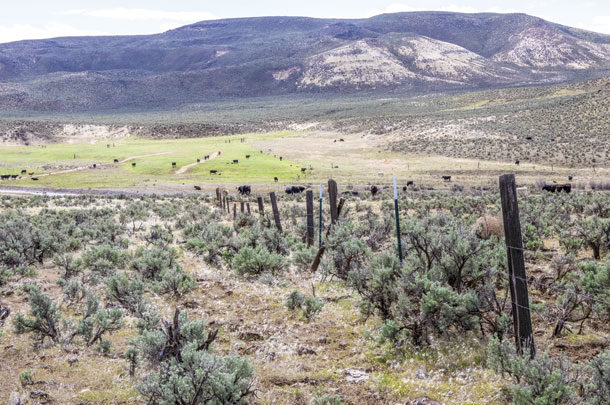Native rangelands are an integral part of the beef industry in many regions of the U.S. In addition to providing a renewable forage resource for livestock, rangelands provide many ecosystem services including plant and wildlife habitat, erosion control, carbon sequestration, and water and nutrient cycling. These services are often maintained on private and public lands by livestock producers, but serve a benefit for the greater community. Sustainable management of rangelands should include considerations for all the ecosystem goods and services rangelands provide.
Assessing the health of rangelands is often difficult to quantify and evaluate because of inherent spatial and temporal variability across our native landscapes. The overall goal is to create an environment where native rangelands are resilient to disturbances and sustainable in forage production.
Resilient, healthy rangelands are better able to resist invasive species and maintain forage for grazing livestock. Resilient rangeland plant communities also have the ability to rebound from disturbance (e.g., drought) to the functionality that was within the community prior to the disturbance.
What is rangeland health?
Rangeland health is defined as the degree to which the integrity of the soil, vegetation, water and ecological processes of the rangeland ecosystems are balanced and sustained. In the Interpreting Indicator of Rangeland Health Technical Reference, Version 5, rangeland health is divided into three attribute categories: soil and site stability, hydrologic function and biotic integrity. Within these three categories are 17 indicators that can be assessed to provide an estimate of the health of a rangeland.
In-depth records and focused monitoring for rangeland health by experienced professionals is a great way to understand rangeland health and track potential changes over time. However, rangeland health can also be assessed informally as you check water, drive through pastures or move cattle. Knowing what to look for as indicators provides a way to get a quick visual assessment of pasture conditions. A few things to look for are found below.
Soil and site stability
Soil and site stability refer to the ability of the rangeland to limit the loss of soil, nutrients, and organic matter by wind and water erosion. To evaluate erosion potential, look at water flow patterns across an area. Is there pedestaling of plants, down-cut areas, or wind-scoured and/or wind deposit areas? Look at the amount of bare ground at localized “high-use” areas and across the pasture as a whole. Is there adequate vegetation cover to resist erosion if a large precipitation event was to occur? If erosion and bare ground are prevalent, there may be underlying issues with management that does not leave enough vegetation and litter cover to maintain soil stability.
Hydrologic function
Healthy hydrologic functions are when a site can adequately capture, store and release water from rainfall, run-on and snowmelt. In many semiarid and arid environments, capturing limited precipitation is very important in maintaining rangeland health. Similar to the soil stability category, evidence of water runoff and erosion indicates the hydrologic functions of the system may be departing from a healthy rangeland system. Litter cover and depth along with plant communities that limit soil erosion are key indicators of the ability of an area to capture water.
Biotic integrity
Biotic integrity refers to living things on the site, particularly rangeland vegetation. A healthy rangeland will support characteristic plant communities on a site that resist loss of function and structure when disturbances (e.g., drought, heavy grazing, fire, etc.) occur. Healthy rangelands also have the ability to recover to their previous condition following disturbance. A key component of this category is knowing what types of vegetation are present on a site at different functional and structural groups (See section below). Additional indicators are vigor of perennial plants, if there are dead and dying plants or plant parts, and if the soil surface is resistant to erosion. Knowing what species should be on a site and the abundance of both native and invasive species will aid in understanding the biotic integrity of a site.
Ecological sites
Rangeland health indicators are assessed at the ecological site scale. An ecological site is a rangeland area with specific soil and physical characteristics that differ from other areas in its ability to produce distinctive kinds of vegetation and respond to management and disturbance. Over many areas, the Natural Resource Conservation Service (NRCS) has a wealth of information on ecological sites. (Visit web soil survey home for more information on your area.) Understanding the capability of a given ecological site and how grazing and other management may affect the site are key to understanding rangeland health.
Many ecological sites have a state-and-transition diagram that can help in understanding rangelands that may have multiple stable vegetation plant communities. Additionally, these diagrams can outline potential thresholds that may shift plant communities into less desirable plant communities. For example, the state-and-transition diagram in Figure 1 describes potential vegetation communities for sands ecological sites in the Nebraska Sandhills.

This ecological site can have several different plant communities.
One example of a compromised biotic integrity in this community is if eastern redcedar encroaches into grassland areas. This has become a problem on many acres in the Sandhills. When enough coverage is reached, a threshold is crossed and the site no longer functions as a grassland with native perennial grasses, but more as a woodland. In extreme cases, this may reduce the foraging potential of the site by more than 75%. If a threshold is crossed with eastern redcedar encroachment, then prescribed burns (PB) or brush management (BM) is required to return the site back to the reference grassland plant communities.
Understanding key indicators of rangeland health provides opportunities to identify and correct potential problems on rangelands. Taking time to understand indicators of rangeland health will help as you visually assess your pastures. ![]()
PHOTO: To see how viable and healthy rangeland is, look for key indicators related to the soil, hydrologic function and biotic integrity. Photo by Mike Dixon.

-
Mitch Stephenson
- Assistant Professor
- Range Management Specialist
- University of Nebraska – Lincoln
- Email Mitch Stephenson











